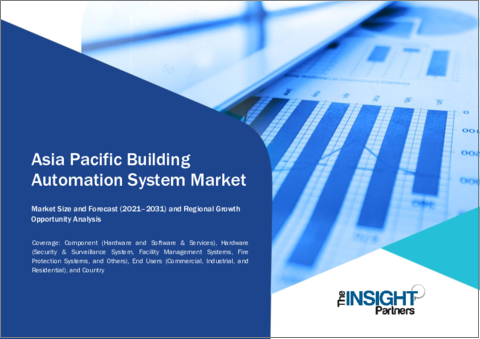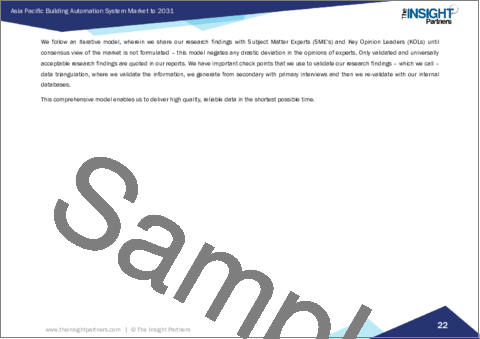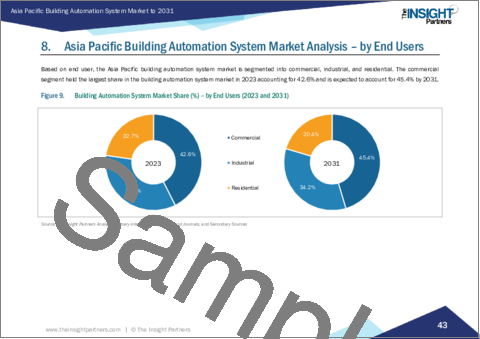|
|
市場調査レポート
商品コード
1666280
アジア太平洋のビルディングオートメーションシステム市場:2031年までの予測 - 地域別分析 - コンポーネント別、エンドユーザー別Asia Pacific Building Automation System Market Forecast to 2031 - Regional Analysis - by Component and End User (Commercial, Industrial, and Residential) |
||||||
|
|||||||
| アジア太平洋のビルディングオートメーションシステム市場:2031年までの予測 - 地域別分析 - コンポーネント別、エンドユーザー別 |
|
出版日: 2025年01月13日
発行: The Insight Partners
ページ情報: 英文 148 Pages
納期: 即納可能
|
- 全表示
- 概要
- 図表
- 目次
アジア太平洋のビルディングオートメーションシステム市場は、2023年に175億4,628万米ドルとなり、2031年までには424億3,281万米ドルに達すると予測され、2023年から2031年までのCAGRは11.7%と推定されます。
持続可能なビルディングオートメーションソリューションへのニーズの高まりがアジア太平洋のビルディングオートメーションシステム市場を後押し
持続可能なビルは、エネルギー消費と二酸化炭素排出の最小化を目指しています。BASは、居住状況や環境条件に基づいてHVAC、照明、その他のシステムを監視、制御、最適化することができます。太陽光や風力などの再生可能エネルギー源へのシフトが進む中、BASはビル運営におけるこれらのエネルギー源の統合と利用をインテリジェントに管理し、エネルギーの最適利用と大幅なコスト削減を実現します。BASは、エネルギー使用量と環境指標に関するデータをリアルタイムで提供し、省エネ戦略や持続可能性基準・規制への準拠について、情報に基づいた意思決定を促します。持続可能なビルは、居住者の快適さと健康を優先します。BASは、室内の空気の質を維持し、温度を調整し、自然採光を最適化することで、居住者の満足度と生産性の向上に貢献します。また、持続可能なBASソリューションは、エネルギー費用の削減、メンテナンスの必要性の低下、機器寿命の延長によるコスト削減をもたらし、ビルの所有者や運営者にとって経済的に魅力的です。持続可能なソリューションの使用は、世界の持続可能性の目標に沿うものであり、エネルギー効率を改善し、居住者の快適性を高め、ビルの所有者や運営者に大きな経済的利益をもたらします。このように、持続可能なビルディングオートメーションソリューションに対するニーズが業界全体で高まっていることから、予測期間中にビルディングオートメーション市場の成長に大きな機会が生まれると期待されています。
アジア太平洋のビルディングオートメーションシステム市場概要
2022年8月、インテリジェントで持続可能な、健康に焦点を当てたビルディングの世界的リーダーとして名高いJohnson Controlsは、Microsoft Beijing Campusと協力し、ビル運営の継続的な改修と強化を行いました。この戦略的提携により、エネルギー消費量の27.9%削減や重要機器の稼働率98%など、目覚ましい成果が得られました。その結果、同キャンパスは省エネルギーで評価され、北京市政府と海淀区政府から財政支援を受けています。このイニシアチブは、2030年までに炭素排出量をピークアウトさせ、2060年までにカーボンニュートラルを達成するという中国の公約に沿うもので、最新の持続可能なエンジニアリング技術を取り入れる建築部門に大きな重点を置いています。このパートナーシップは、AIと高度なビルディングオートメーションシステムによって、大規模なビル運営におけるエネルギー効率と運用の自動化を大幅に強化できることを示す好例となっています。Microsoft Beijing Campusはまた、Johnson ControlsのMetasysビルディングオートメーションシステム(BAS)を利用して冷暖房機器を監視し、重要なデータをOBEMに流して分析しています。このような協力体制が、アジア太平洋のビルディングオートメーションシステム市場を牽引しています。
アジア太平洋のビルディングオートメーションシステム市場の収益と2031年までの予測(金額)
アジア太平洋のビルディングオートメーションシステム市場のセグメンテーション
アジア太平洋のビルディングオートメーションシステム市場は、コンポーネント、エンドユーザー、国に分類されます。
コンポーネントに基づき、アジア太平洋のビルディングオートメーションシステム市場はハードウェアとソフトウェア・サービスに二分されます。2023年の市場シェアはハードウェアセグメントが大きいです。さらに、ハードウェアセグメントは、セキュリティ・監視システム、施設管理システム、防火システム、その他にサブセグメント化されます。
エンドユーザー別では、アジア太平洋のビルディングオートメーションシステム市場は、商業、産業、住宅にセグメント化されます。2023年には、商業セグメントが最大の市場シェアを占めました。
国別では、アジア太平洋のビルディングオートメーションシステム市場は、オーストラリア、中国、インド、日本、韓国、その他アジア太平洋に区分されます。2023年のアジア太平洋ビルディングオートメーションシステム市場シェアは中国が独占しました。
ABB Ltd、Mitsubishi Electric Corp、Bosch Sicherheitssysteme GmbH、Honeywell international Inc、Schneider Electric SE、Siemens AG、Johnson Controls International Plc、Carrier Global Corp、Lutron Electronics Co., Inc、Tran Technologies Plcは、アジア太平洋のビルディングオートメーションシステム市場で事業を展開している主要企業です。
目次
第1章 イントロダクション
第2章 エグゼクティブサマリー
- 主要洞察
- 市場の魅力
第3章 調査手法
- 2次調査
- 1次調査
- 仮説の策定
- マクロ経済要因分析
- 基礎数値の開発
- データの三角測量
- 国レベルのデータ
第4章 アジア太平洋のビルディングオートメーションシステム市場情勢
- エコシステム分析
- バリューチェーンのベンダー一覧
第5章 アジア太平洋のビルディングオートメーションシステム市場:主要市場力学
- 市場促進要因
- ビル居住者の快適性、安全性、セキュリティ強化に対するニーズの高まり
- 無線センサーネットワーク技術と無線プロトコルのビルディングオートメーションシステムへの統合
- 市場抑制要因
- 熟練した専門家の不足
- 高い設置・導入コスト
- 市場機会
- 持続可能なビルディングオートメーションソリューションへのニーズの高まり
- スマートシティプロジェクトへの取り組みの高まり
- 今後の動向
- コンシューマーIoT、IPベースデバイス、SaaS、その他の技術開発
- 促進要因と抑制要因の影響
第6章 ビルディングオートメーションシステム市場:アジア太平洋の分析
- アジア太平洋のビルディングオートメーションシステム市場概要
- ビルディングオートメーションシステムの市場収益、2021年~2031年
- ビルディングオートメーションシステム市場の予測分析
第7章 アジア太平洋のビルディングオートメーションシステム市場分析:コンポーネント別
- ハードウェア
- ソフトウェア・サービス
第8章 アジア太平洋のビルディングオートメーションシステム市場分析:エンドユーザー別
- 商業
- 工業用
- 住宅
第9章 アジア太平洋のビルディングオートメーションシステム市場:国別分析
- アジア太平洋市場概要
- アジア太平洋
- オーストラリア
- 中国
- インド
- 日本
- 韓国
- その他アジア太平洋
- アジア太平洋
第10章 競合情勢
- 各社のポジショニングと集中度
- ヒートマップ分析:主要企業別
第11章 業界情勢
- 市場イニシアティブ
- 製品開発
- 合併と買収
第12章 企業プロファイル
- ABB Ltd
- Mitsubishi Electric Corp
- Bosch Sicherheitssysteme GmbH
- Honeywell International Inc
- Schneider Electric SE
- Siemens AG
- Johnson Controls International Plc
- Carrier Global Corp
- Lutron Electronics Co., Inc
- Trane Technologies Plc
第13章 付録
List Of Tables
- Table 1. Asia Pacific Building Automation System Market Segmentation
- Table 2. List of Vendors
- Table 3. Building Automation System Market - Revenue and Forecast to 2031 (US$ Million)
- Table 4. Building Automation System Market - Revenue and Forecast to 2031 (US$ Million) - by Component
- Table 5. Building Automation System Market - Revenue and Forecast to 2031 (US$ Million) - by Hardware
- Table 6. Building Automation System Market - Revenue and Forecast to 2031 (US$ Million) - by End Users
- Table 7. Asia Pacific: Building Automation System Market - Revenue and Forecast to 2031 (US$ Million) - by Country
- Table 8. Australia: Building Automation System Market - Revenue and Forecast to 2031 (US$ Million) - by Component
- Table 9. Australia: Building Automation System Market - Revenue and Forecast to 2031 (US$ Million) - by Hardware
- Table 10. Australia: Building Automation System Market - Revenue and Forecast to 2031 (US$ Million) - by End Users
- Table 11. China: Building Automation System Market - Revenue and Forecast to 2031 (US$ Million) - by Component
- Table 12. China: Building Automation System Market - Revenue and Forecast to 2031 (US$ Million) - by Hardware
- Table 13. China: Building Automation System Market - Revenue and Forecast to 2031 (US$ Million) - by End Users
- Table 14. India: Building Automation System Market - Revenue and Forecast to 2031 (US$ Million) - by Component
- Table 15. India: Building Automation System Market - Revenue and Forecast to 2031 (US$ Million) - by Hardware
- Table 16. India: Building Automation System Market - Revenue and Forecast to 2031 (US$ Million) - by End Users
- Table 17. Japan: Building Automation System Market - Revenue and Forecast to 2031 (US$ Million) - by Component
- Table 18. Japan: Building Automation System Market - Revenue and Forecast to 2031 (US$ Million) - by Hardware
- Table 19. Japan: Building Automation System Market - Revenue and Forecast to 2031 (US$ Million) - by End Users
- Table 20. South Korea: Building Automation System Market - Revenue and Forecast to 2031 (US$ Million) - by Component
- Table 21. South Korea: Building Automation System Market - Revenue and Forecast to 2031 (US$ Million) - by Hardware
- Table 22. South Korea: Building Automation System Market - Revenue and Forecast to 2031 (US$ Million) - by End Users
- Table 23. Rest of APAC: Building Automation System Market - Revenue and Forecast to 2031 (US$ Million) - by Component
- Table 24. Rest of APAC: Building Automation System Market - Revenue and Forecast to 2031 (US$ Million) - by Hardware
- Table 25. Rest of APAC: Building Automation System Market - Revenue and Forecast to 2031 (US$ Million) - by End Users
- Table 26. Heat Map Analysis by Key Players
- Table 27. List of Abbreviation
List Of Figures
- Figure 1. Asia Pacific Building Automation System Market Segmentation, by Country
- Figure 2. Ecosystem Analysis
- Figure 3. Building Automation System Market - Key Market Dynamics
- Figure 4. Impact Analysis of Drivers and Restraints
- Figure 5. Building Automation System Market Revenue (US$ Million), 2021-2031
- Figure 6. Building Automation System Market Share (%) - by Component (2023 and 2031)
- Figure 7. Hardware: Building Automation System Market - Revenue and Forecast to 2031 (US$ Million)
- Figure 8. Software & Services: Building Automation System Market - Revenue and Forecast to 2031 (US$ Million)
- Figure 9. Building Automation System Market Share (%) - by End Users (2023 and 2031)
- Figure 10. Commercial: Building Automation System Market - Revenue and Forecast to 2031 (US$ Million)
- Figure 11. Industrial: Building Automation System Market - Revenue and Forecast to 2031 (US$ Million)
- Figure 12. Residential: Building Automation System Market - Revenue and Forecast to 2031 (US$ Million)
- Figure 13. Asia Pacific Building Automation System Market, by Key Countries - Revenue (2023) (US$ Million)
- Figure 14. Asia Pacific: Building Automation System Market Breakdown, by Key Countries, 2023 and 2031 (%)
- Figure 15. Australia: Building Automation System Market - Revenue and Forecast to 2031 (US$ Million)
- Figure 16. China: Building Automation System Market - Revenue and Forecast to 2031 (US$ Million)
- Figure 17. India: Building Automation System Market - Revenue and Forecast to 2031 (US$ Million)
- Figure 18. Japan: Building Automation System Market - Revenue and Forecast to 2031 (US$ Million)
- Figure 19. South Korea: Building Automation System Market - Revenue and Forecast to 2031 (US$ Million)
- Figure 20. Rest of APAC: Building Automation System Market - Revenue and Forecast to 2031 (US$ Million)
- Figure 21. Company Positioning & Concentration
The Asia Pacific building automation system market was valued at US$ 17,546.28 million in 2023 and is expected to reach US$ 42,432.81 million by 2031; it is estimated to register a CAGR of 11.7% from 2023 to 2031.
Growing Need for Sustainable Building Automation Solutions Boosts Asia Pacific Building Automation System Market
Sustainable buildings aim to minimize energy consumption and carbon emissions. BAS can monitor, control, and optimize HVAC, lighting, and other systems based on occupancy and environmental conditions. With an increasing shift toward renewable energy sources, such as solar and wind, BAS can intelligently manage the integration and utilization of these sources within building operations, ensuring optimal energy use and substantial cost savings. BAS provides real-time data on energy usage and environmental metrics, facilitating informed decision-making for energy conservation strategies and compliance with sustainability standards and regulations. Sustainable buildings prioritize occupant comfort and health. BAS can maintain indoor air quality, regulate temperature, and optimize natural lighting, contributing to enhanced occupant satisfaction and productivity. Also, sustainable BAS solutions result in cost savings due to reduced energy expenses, lower maintenance needs, and prolonged equipment life, making them financially attractive for building owners and operators. The use of sustainable solutions aligns with global sustainability goals, improving energy efficiency, enhancing occupant comfort, and offering significant economic benefits for building owners and operators. Thus, the growing need for sustainable building automation solutions across industries is expected to create significant opportunities for the building automation market growth during the forecast period.
Asia Pacific Building Automation System Market Overview
In August 2022, Johnson Controls, a renowned global leader in intelligent, sustainable, and health-focused buildings, collaborated with Microsoft Beijing Campus to continually renovate and enhance building operations. This strategic alliance has yielded remarkable results, including a 27.9% reduction in energy consumption and a 98% uptime for critical equipment. Consequently, the campus has received recognition for energy conservation and financial support from the Beijing Municipal Government and the Haidian District Government. This initiative aligns with China's commitment to peak carbon emissions by 2030 and achieve carbon neutrality by 2060, placing significant emphasis on the building sector to embrace the latest sustainable engineering technology. This partnership serves as a prime example of how AI and advanced building automation systems can significantly enhance energy efficiency and operational automation in large-scale building operations. Microsoft Beijing Campus also utilizes Johnson Controls Metasys Building Automation System (BAS) to monitor cooling and heating equipment, channeling significant data into OBEM for analysis. Such collaboration initiatives drive the Asia Pacific building automation system market .
Asia Pacific Building Automation System Market Revenue and Forecast to 2031 (US$ Million)
Asia Pacific Building Automation System Market Segmentation
The Asia Pacific building automation system market is categorized into component, end user, and country.
Based on component, the Asia Pacific building automation system market is bifurcated into hardware and software & services. The hardware segment held a larger market share in 2023. Furthermore, the hardware segment is sub segmented into security & surveillance system, facility management systems, fire protection systems, and others.
In terms of end user, the Asia Pacific building automation system market is segmented into commercial, industrial, and residential. The commercial segment held the largest market share in 2023.
By country, the Asia Pacific building automation system market is segmented into Australia, China, India, Japan, South Korea, and the Rest of Asia Pacific. China dominated the Asia Pacific building automation system market share in 2023.
ABB Ltd; Mitsubishi Electric Corp; Bosch Sicherheitssysteme GmbH; Honeywell international Inc; Schneider Electric SE; Siemens AG; Johnson Controls International Plc; Carrier Global Corp; Lutron Electronics Co., Inc; and Trane Technologies Plc are some of the leading companies operating in the Asia Pacific building automation system market.
Table Of Contents
1. Introduction
- 1.1 The Insight Partners Research Report Guidance
- 1.2 Market Segmentation
2. Executive Summary
- 2.1 Key Insights
- 2.2 Market Attractiveness
3. Research Methodology
- 1.1 Secondary Research
- 1.2 Primary Research
- 3.1.1 Hypothesis formulation:
- 3.1.2 Macro-economic factor analysis:
- 3.1.3 Developing base number:
- 3.1.4 Data Triangulation:
- 3.1.5 Country level data:
4. Asia Pacific Building Automation System Market Landscape
- 4.1 Overview
- 4.2 Ecosystem Analysis
- 4.2.1 List of Vendors in the Value Chain
5. Asia Pacific Building Automation System Market - Key Market Dynamics
- 5.1 Market Drivers
- 5.1.1 Rise in Need for Enhanced Comfort, Safety, and Security Among Building Occupants
- 5.1.2 Integration of Wireless Sensor Network Technology and Wireless Protocols with Building Automation Systems
- 5.2 Market Restraints
- 5.2.1 Lack of Skilled Professionals
- 5.2.2 High Installation and Implementation Cost
- 5.3 Market Opportunities
- 5.3.1 Growing Need for Sustainable Building Automation Solutions
- 5.3.2 Rising Initiatives in Smart City Projects
- 5.4 Future Trends
- 5.4.1 Consumer IoT, IP-based Devices, SaaS, and Other Technological Developments
- 5.5 Impact of Drivers and Restraints:
6. Building Automation System Market - Asia Pacific Analysis
- 6.1 Asia Pacific Building Automation System Market Overview
- 6.2 Building Automation System Market Revenue (US$ Million), 2021-2031
- 6.3 Building Automation System Market Forecast Analysis
7. Asia Pacific Building Automation System Market Analysis - by Component
- 7.1 Hardware
- 7.1.1 Overview
- 7.1.2 Hardware: Building Automation System Market - Revenue and Forecast to 2031 (US$ Million)
- 7.2 Software & Services
- 7.2.1 Overview
- 7.2.2 Software & Services: Building Automation System Market - Revenue and Forecast to 2031 (US$ Million)
8. Asia Pacific Building Automation System Market Analysis - by End Users
- 8.1 Commercial
- 8.1.1 Overview
- 8.1.2 Commercial: Building Automation System Market - Revenue and Forecast to 2031 (US$ Million)
- 8.2 Industrial
- 8.2.1 Overview
- 8.2.2 Industrial: Building Automation System Market - Revenue and Forecast to 2031 (US$ Million)
- 8.3 Residential
- 8.3.1 Overview
- 8.3.2 Residential: Building Automation System Market - Revenue and Forecast to 2031 (US$ Million)
9. Asia Pacific Building Automation System Market - Country Analysis
- 9.1 Asia Pacific Market Overview
- 9.1.1 Asia Pacific: Building Automation System Market Breakdown, 2023 and 2031 (%) - by Country
- 9.1.1.1 Asia Pacific: Building Automation System Market - Revenue and Forecast Analysis - by Country
- 9.1.1.2 Australia: Building Automation System Market - Revenue and Forecast to 2031 (US$ Million)
- 9.1.1.2.1 Australia: Building Automation System Market - Revenue and Forecast Analysis, by Component
- 9.1.1.2.2 Australia: Building Automation System Market - Revenue and Forecast Analysis, by Hardware
- 9.1.1.2.3 Australia: Building Automation System Market - Revenue and Forecast Analysis, by End Users
- 9.1.1.3 China: Building Automation System Market - Revenue and Forecast to 2031 (US$ Million)
- 9.1.1.3.1 China: Building Automation System Market - Revenue and Forecast Analysis, by Component
- 9.1.1.3.2 China: Building Automation System Market - Revenue and Forecast Analysis, by Hardware
- 9.1.1.3.3 China: Building Automation System Market - Revenue and Forecast Analysis, by End Users
- 9.1.1.4 India: Building Automation System Market - Revenue and Forecast to 2031 (US$ Million)
- 9.1.1.4.1 India: Building Automation System Market - Revenue and Forecast Analysis, by Component
- 9.1.1.4.2 India: Building Automation System Market - Revenue and Forecast Analysis, by Hardware
- 9.1.1.4.3 India: Building Automation System Market - Revenue and Forecast Analysis, by End Users
- 9.1.1.5 Japan: Building Automation System Market - Revenue and Forecast to 2031 (US$ Million)
- 9.1.1.5.1 Japan: Building Automation System Market - Revenue and Forecast Analysis, by Component
- 9.1.1.5.2 Japan: Building Automation System Market - Revenue and Forecast Analysis, by Hardware
- 9.1.1.5.3 Japan: Building Automation System Market - Revenue and Forecast Analysis, by End Users
- 9.1.1.6 South Korea: Building Automation System Market - Revenue and Forecast to 2031 (US$ Million)
- 9.1.1.6.1 South Korea: Building Automation System Market - Revenue and Forecast Analysis, by Component
- 9.1.1.6.2 South Korea: Building Automation System Market - Revenue and Forecast Analysis, by Hardware
- 9.1.1.6.3 South Korea: Building Automation System Market - Revenue and Forecast Analysis, by End Users
- 9.1.1.7 Rest of APAC: Building Automation System Market - Revenue and Forecast to 2031 (US$ Million)
- 9.1.1.7.1 Rest of APAC: Building Automation System Market - Revenue and Forecast Analysis, by Component
- 9.1.1.7.2 Rest of APAC: Building Automation System Market - Revenue and Forecast Analysis, by Hardware
- 9.1.1.7.3 Rest of APAC: Building Automation System Market - Revenue and Forecast Analysis, by End Users
- 9.1.1 Asia Pacific: Building Automation System Market Breakdown, 2023 and 2031 (%) - by Country
10. Competitive Landscape
- 10.1 Company Positioning & Concentration
- 10.2 Heat Map Analysis by Key Players
11. Industry Landscape
- 11.1 Overview
- 11.2 Market Initiative
- 11.3 Product Development
- 11.4 Mergers & Acquisitions
12. Company Profiles
- 12.1 ABB Ltd
- 12.1.1 Key Facts
- 12.1.2 Business Description
- 12.1.3 Products and Services
- 12.1.4 Financial Overview
- 12.1.5 SWOT Analysis
- 12.1.6 Key Developments
- 12.2 Mitsubishi Electric Corp
- 12.2.1 Key Facts
- 12.2.2 Business Description
- 12.2.3 Products and Services
- 12.2.4 Financial Overview
- 12.2.5 SWOT Analysis
- 12.2.6 Key Developments
- 12.3 Bosch Sicherheitssysteme GmbH
- 12.3.1 Key Facts
- 12.3.2 Business Description
- 12.3.3 Products and Services
- 12.3.4 Financial Overview
- 12.3.5 SWOT Analysis
- 12.3.6 Key Developments
- 12.4 Honeywell International Inc
- 12.4.1 Key Facts
- 12.4.2 Business Description
- 12.4.3 Products and Services
- 12.4.4 Financial Overview
- 12.4.5 SWOT Analysis
- 12.4.6 Key Developments
- 12.5 Schneider Electric SE
- 12.5.1 Key Facts
- 12.5.2 Business Description
- 12.5.3 Products and Services
- 12.5.4 Financial Overview
- 12.5.5 SWOT Analysis
- 12.5.6 Key Developments
- 12.6 Siemens AG
- 12.6.1 Key Facts
- 12.6.2 Business Description
- 12.6.3 Products and Services
- 12.6.4 Financial Overview
- 12.6.5 SWOT Analysis
- 12.6.6 Key Developments
- 12.7 Johnson Controls International Plc
- 12.7.1 Key Facts
- 12.7.2 Business Description
- 12.7.3 Products and Services
- 12.7.4 Financial Overview
- 12.7.5 SWOT Analysis
- 12.7.6 Key Developments
- 12.8 Carrier Global Corp
- 12.8.1 Key Facts
- 12.8.2 Business Description
- 12.8.3 Products and Services
- 12.8.4 Financial Overview
- 12.8.5 SWOT Analysis
- 12.8.6 Key Developments
- 12.9 Lutron Electronics Co., Inc
- 12.9.1 Key Facts
- 12.9.2 Business Description
- 12.9.3 Products and Services
- 12.9.4 Financial Overview
- 12.9.5 SWOT Analysis
- 12.9.6 Key Developments
- 12.10 Trane Technologies Plc
- 12.10.1 Key Facts
- 12.10.2 Business Description
- 12.10.3 Products and Services
- 12.10.4 Financial Overview
- 12.10.5 SWOT Analysis
- 12.10.6 Key Developments
13. Appendix
- 13.1 Word Index
- 13.2 About The Insight Partners





